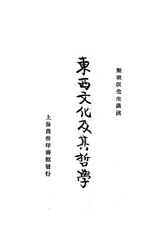File:NLC416-16jh000047-83383 東西文化及其哲學.pdf

Original file (852 × 1,275 pixels, file size: 13.05 MB, MIME type: application/pdf, 300 pages)
Captions
Captions
Summary
edit| 東西文化及其哲學
( |
||||||||||||||||||||||||
|---|---|---|---|---|---|---|---|---|---|---|---|---|---|---|---|---|---|---|---|---|---|---|---|---|
| Author |
梁漱溟講演 |
|||||||||||||||||||||||
| Title |
東西文化及其哲學 |
|||||||||||||||||||||||
| Publisher |
商務印書館[發行者] |
|||||||||||||||||||||||
| Description |
在作者1921年10月在山東省教育會講演的基礎上並參酌1920年在北京大學的講演寫成。書中提出世界上有西洋文化、中國文化、印度文化,認為東方文化比西洋文化為高,指出「要以孔教為中心使東西文化雙方湊合」,西洋人要走「中國的路,孔家的路」,從而使中國文化成為世界文化。全書分為五章:緒論,如何是東方化、西方化,西洋、中國、印度三方哲學之比較,世界未來之文化與我們今日應持的態度。時論匯錄有:《東西民族根本思想之差異》(陳獨秀),《東西文明根本之差異》(李大釗),《東西文明之比較》(日本早稻田大學教授金子馬治),《中西文明之評判》(平佚譯自日本《東亞之光》),《戰後東西文明之調和》(傖父)等
目錄 |
|||||||||||||||||||||||
| Language | Chinese | |||||||||||||||||||||||
| Publication date | 民國十四年[1925] | |||||||||||||||||||||||
| Source |
institution QS:P195,Q732353
(民國時期文獻 民國圖書) |
|||||||||||||||||||||||
| 館藏信息 InfoField | MG/B1-03/1 | |||||||||||||||||||||||
| 主題 InfoField | 比較哲學 | |||||||||||||||||||||||
| 中圖分類 InfoField | B1-03 | |||||||||||||||||||||||
| 載體形態 InfoField | 216,66頁 | |||||||||||||||||||||||
Licensing
editThis image is in the public domain because it is a mere mechanical scan or photocopy of a public domain original, or – from the available evidence – is so similar to such a scan or photocopy that no copyright protection can be expected to arise. The original itself is in the public domain for the following reason:
This tag is designed for use where there may be a need to assert that any enhancements (eg brightness, contrast, colour-matching, sharpening) are in themselves insufficiently creative to generate a new copyright. It can be used where it is unknown whether any enhancements have been made, as well as when the enhancements are clear but insufficient. For known raw unenhanced scans you can use an appropriate {{PD-old}} tag instead. For usage, see Commons:When to use the PD-scan tag. |
| This image contains digital watermarking or credits in the image itself. The usage of visible watermarks is discouraged. If a non-watermarked version of the image is available, please upload it under the same file name and then remove this template. Ensure that removed information is present in the image description page and replace this template with {{Metadata from image}} or {{Attribution metadata from licensed image}}.
Caution: Before removing a watermark from a copyrighted image, please read the WMF's analysis of the legal ramifications of doing so, as well as Commons' proposed policy regarding watermarks. If the old version is still useful, for example if removing the watermark damages the image significantly, upload the new version under a different title so that both can be used. After uploading the non-watermarked version, replace this template with{{Superseded|new filename|version without watermarks}}.Bahasa Indonesia ∙ italiano ∙ eesti ∙ sicilianu ∙ Deutsch ∙ català ∙ magyar ∙ čeština ∙ română ∙ español ∙ português ∙ English ∙ hrvatski ∙ Plattdüütsch ∙ français ∙ Nederlands ∙ polski ∙ galego ∙ slovenščina ∙ suomi ∙ svenska ∙ Ελληνικά ∙ беларуская (тарашкевіца) ∙ български ∙ македонски ∙ русский ∙ українська ∙ മലയാളം ∙ ไทย ∙ 日本語 ∙ 中文 ∙ 中文(简体) ∙ 中文(繁體) ∙ עברית ∙ العربية ∙ فارسی ∙ +/− |
File history
Click on a date/time to view the file as it appeared at that time.
| Date/Time | Thumbnail | Dimensions | User | Comment | |
|---|---|---|---|---|---|
| current | 16:08, 21 April 2023 |  | 852 × 1,275, 300 pages (13.05 MB) | PencakeBot (talk | contribs) | Upload 東西文化及其哲學 (1/1) by 梁漱溟講演 (batch task; nlc:data_416,16jh000047,83383; 民國圖書-PD2022.5; 東西文化及其哲學) |
You cannot overwrite this file.
File usage on Commons
The following page uses this file:
Metadata
This file contains additional information such as Exif metadata which may have been added by the digital camera, scanner, or software program used to create or digitize it. If the file has been modified from its original state, some details such as the timestamp may not fully reflect those of the original file. The timestamp is only as accurate as the clock in the camera, and it may be completely wrong.
| Conversion program | Foxit GSDK - Foxit Software Inc. |
|---|---|
| Encrypted | no |
| Page size |
|
| Version of PDF format | 1.7 |





